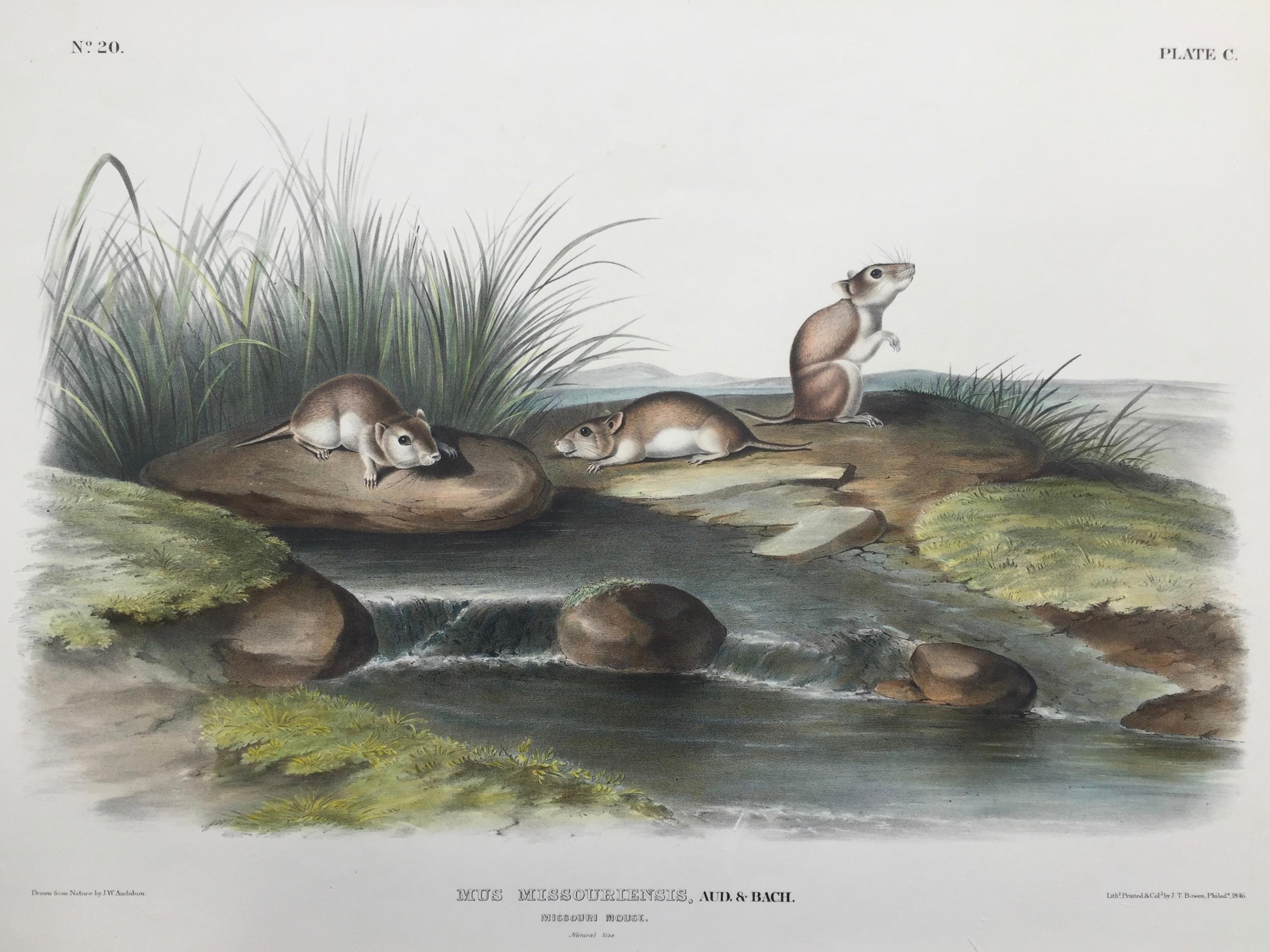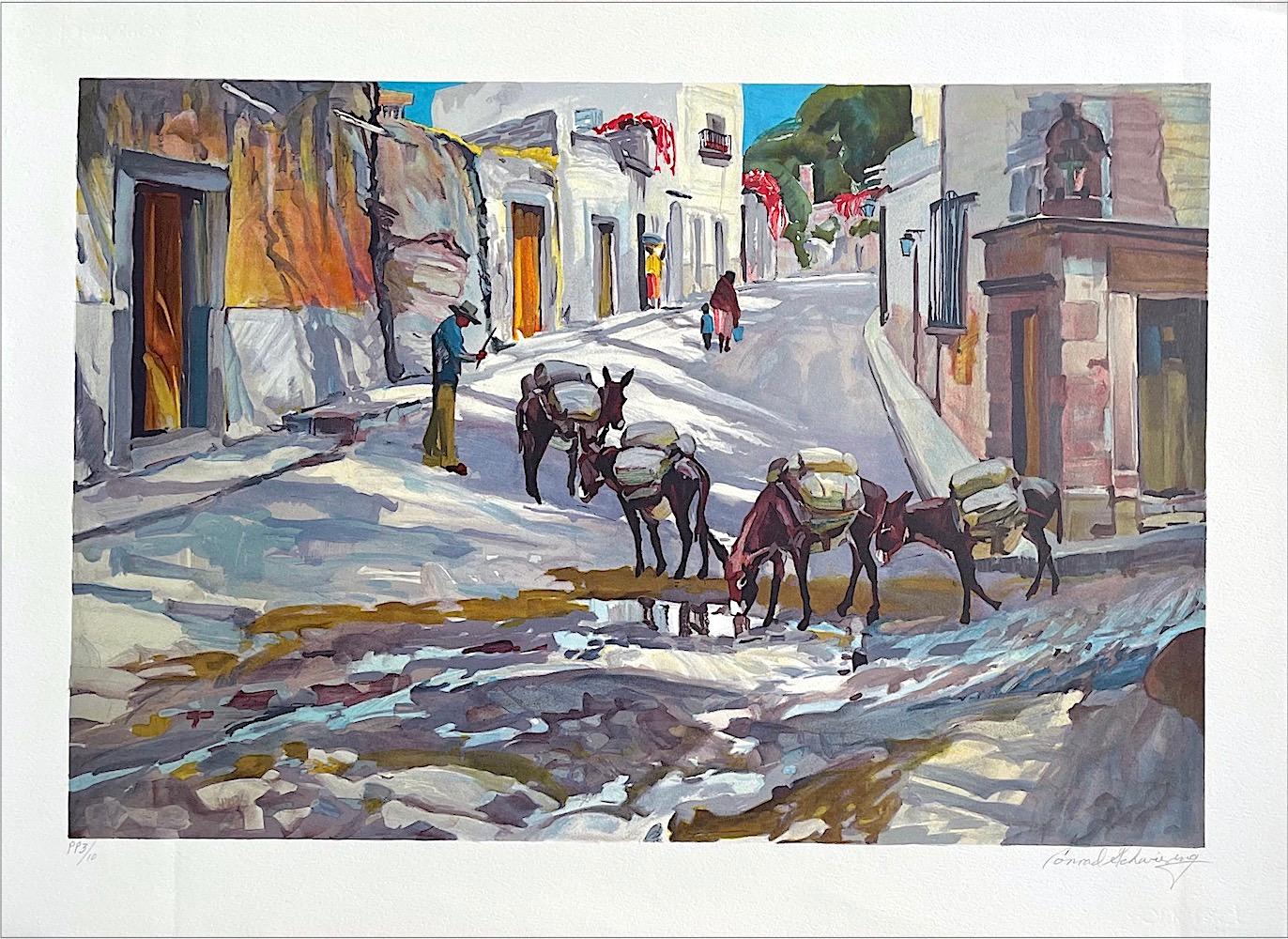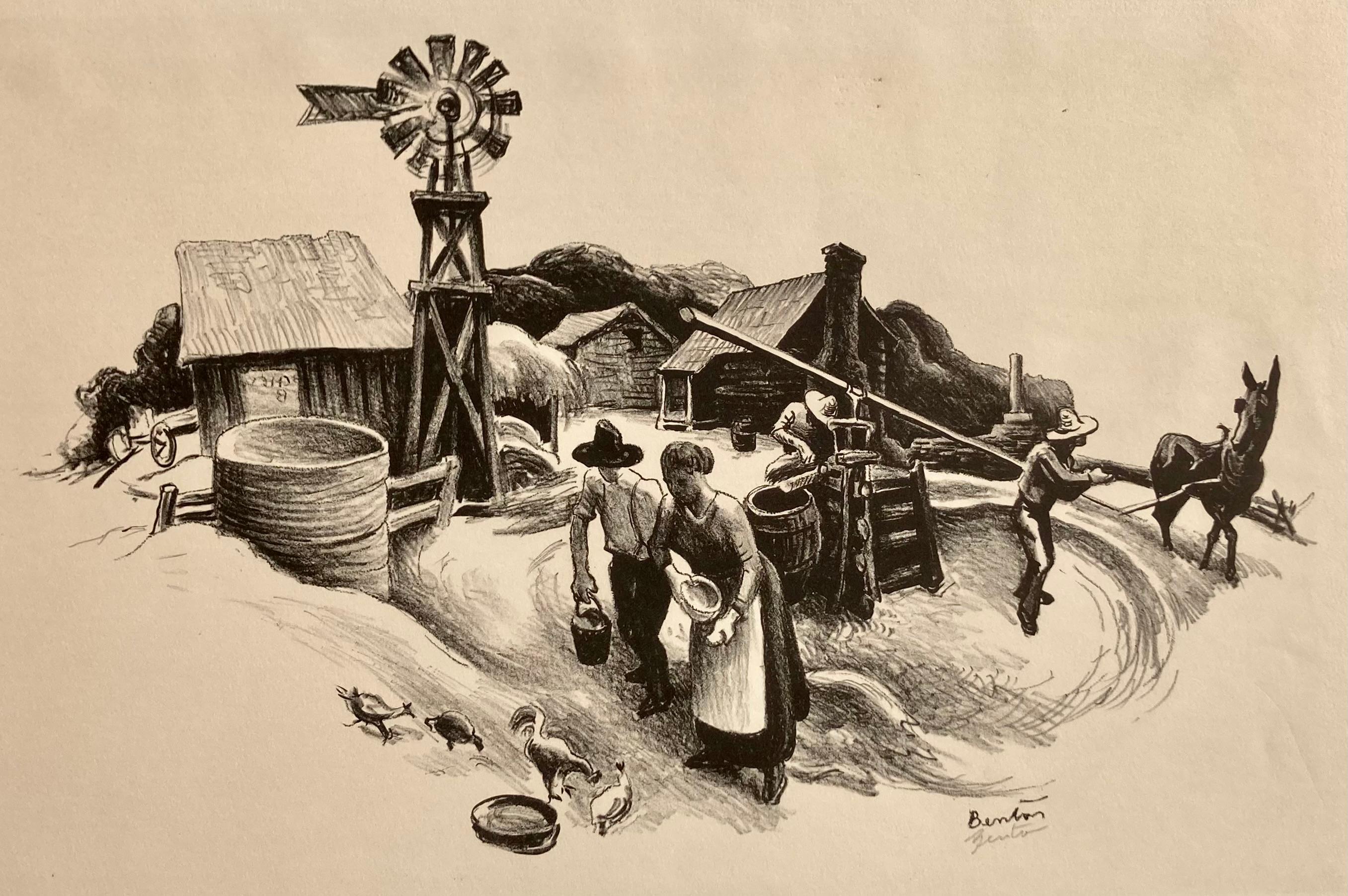Items Similar to One of Their Pets (Two Farm Boys and Cow at the Watering Hole)
Want more images or videos?
Request additional images or videos from the seller
1 of 5
Joseph VorstOne of Their Pets (Two Farm Boys and Cow at the Watering Hole)
About the Item
One of Their Pets (Two Farm Boys and Cow at The Watering Hole)
By Joseph Vorst (1897-1947)
Signed Lower Right
Edition 1/50 Lower Left
Unframed: 8.5" x 11"
Framed: 16" x 18.5"
German-born Joseph Vorst came from Essen (born June 19, 1897). His teacher was the leading German impressionist Max Liebermann (1847-1935), who was the champion of French impressionism in Berlin. He had traveled to Barbizon and Paris to see paintings by Manet first hand, including In the Conservatory, which made its way to Berlin. Later Vorst's home town of Essen would acquire a collection of modern art in 1921, which became the Museum Folkwang, one of the earliest of its kind.
Most likely to escape the Nazis, Vorst made his way to Missouri; we know that he was a member of the American Artists Congress and he signed the famous "Call" in 1936 at the group's first congress, the left-wing organization that stood up to combat fascism. Surely he would have known Joe Jones (1909-1963), the representative on the National Executive Committee from St. Louis who was later reprimanded for producing Communist propaganda at his art classes for homeless youth set up in the St. Louis Court House. Vorst also knew Thomas Hart Benton, called his friend and associate.
In 1936 Vorst exhibited Missouri Mules at the Art Institute of Chicago. His paintings Drifters on the Mississippi and Picking Strawberries were on display there in the two subsequent annual exhibitions. Then in 1939, Vorst's Drought was shown at the Corcoran biennial and on a grander scale, many more viewers saw his Madonna of the Tiff Miners at the New York World's Fair that year. During what amounted to a "peak year" for Vorst, his work entitled Fear was part of the art exhibited at the Golden Gate International Exposition in San Francisco. At the same time, Vorst was working on a mural in the Vandalia, Missouri Post Office called Corn Harvest. In 1940 Vorst took on another decorative project for the Paris, Arkansas Post Office (Rural Arkansas). One further post office mural came in 1942 - Time Out - in Bethany, Missouri.
Vorst was honored with one-man shows in New York, Washington and St. Louis. He re-exhibited Picking Strawberries in 1940 at the Pennsylvania Academy of the Fine Arts and a year later his After Flood (Robert Henry Adams Fine Art, Chicago) appeared there. In 1942 Vorst showed Refugees at the Whitney Annual and a year later his Good Lord Gives Peace was on view at the Corcoran Gallery and at the Art Institute of Chicago. For two more years Vorst submitted paintings to the Whitney: Family Festival (1945) and The Keeper (1946). Vorst also worked as an illustrator for Esquire and executed lithographs. He died in 1947 at the age of fifty. The St. Louis Art Museum has Vorst's painting, For Thine is the Kingdom.
- Creator:Joseph Vorst (1897 - 1947, American)
- Dimensions:Height: 8.5 in (21.59 cm)Width: 11 in (27.94 cm)
- Medium:
- Movement & Style:
- Period:
- Condition:
- Gallery Location:Missouri, MO
- Reference Number:1stDibs: LU747310910752
About the Seller
5.0
Vetted Seller
These experienced sellers undergo a comprehensive evaluation by our team of in-house experts.
Established in 1970
1stDibs seller since 2017
141 sales on 1stDibs
Typical response time: 22 hours
- ShippingRetrieving quote...Ships From: Missouri, MO
- Return PolicyA return for this item may be initiated within 2 days of delivery.
More From This SellerView All
- Herring GullsBy Jamie WyethLocated in Missouri, MOJamie Wyeth "Herring Gulls" 1978 Color Lithograph Signed Lower Right Numbered Lower Left 149/300 Born in 1946, James Browning Wyeth came of age when the meaning of patriotism was clouded by the traumas of the Vietnam War and the scandals of Watergate. Working in an era of turmoil and questioning of governmental authority, he did art that encompassed both marching off to war and marching in protest. One of James's early masterworks, Draft Age (1965) depicts a childhood friend as a defiant Vietnam-era teenager resplendent in dark sunglasses and black leather jacket in a suitably insouciant pose. Two years later Wyeth painstakingly composed a haunting, posthumous Portrait of President John F. Kennedy (1967) that seems to catch the martyred Chief Executive in a moment of agonized indecision. As Wyeth Center curator Lauren Raye Smith points out, Wyeth "did not deify the slain president, [but] on the contrary made him seem almost too human." Based on hours of study and sketching of JFK's brothers Robert and Edward - documented by insightful studies in the exhibition - the final, pensive portrait seemed too realistic to family members and friends. "His brother Robert," writes Smith in the exhibition catalogue, "reportedly felt uneasy about this depiction, and said it reminded him of the President during the Bay of Pigs invasion." In spite of these misgivings, James's JFK likeness has been reproduced frequently and is one of the highlights of this show. The poignancy, appeal and perceptiveness of this portrait, painted when the youngest Wyeth was 21 years old, makes one wish he would do more portraits of important public figures. James himself feels he is at his best painting people he knows well, as exemplified by his vibrant Portrait of Jean Kennedy Smith (1972), which captures the vitality of the slain President's handsome sister. He did paint a portrait of Jimmy Carter for the January 1977 man-of-the-year cover of Time magazine, showing the casually dressed President-elect as a straightforward character posed under a flag-draped water tower next to the family peanut plant in Plains, Ga. James recalls that Carter had one Secret Service agent guarding him as he posed outdoors, a far cry from the protection our Chief Executives require today. As a participating artist in the "Eyewitness to Space" program organized by the National Aeronautics and Space Administration in collaboration with the National Gallery of Art in the late 1960s, Wyeth deftly recorded in a series of watercolors his eyewitness observations of dramatic spacecraft launchings and more mundane scenes associated with the space program. Commissioned by Harper's Magazine to cover the 1974 congressional hearings and trials of Watergate figures, James Wyeth executed a series of perceptive and now evocative sketches that recall those dark chapters in our history. Memorable images include a scowling John Ehrlichman, a hollow-eyed Bob Haldeman, an owlish Charles Colson, a focused Congressman Peter Rodino, a grim visaged Father/ Congressman Robert Drinan, and vignettes of the press and various courtroom activities. An 11-by-14-inch pencil sketch of the unflappable Judge John Sirica is especially well done. These "images are powerful as historical records," observes Smith, "and as lyrically journalistic impressions of events that changed the nation forever." Wyeth's sketch of early-morning crowds lined up outside the Supreme Court building hoping to hear the Watergate case, with the ubiquitous TV cameramen looking on, is reminiscent of recent scenes as the high court grappled with the Bush-Gore contest. The Wyeth family penchant for whimsy and enigmatic images is evident in Islanders (1990), showing two of James's friends, wearing goofy hats, sitting on the porch of a small Monhegan Island (Me.) cottage draped with a large American flag. Mixing the serious symbolism of Old Glory with the irreverent appearance of the two men, James has created a puzzling but interesting composition. Painting White House...Category
1970s American Modern Animal Prints
MaterialsPaper, Lithograph
- Hurry SundownBy Billy SchenckLocated in Missouri, MOBilly Schenck (American, b. 1947) Hurry Sundown, 1985 Edition 19/60 Serigraph 21 x 38 inches Signed, Titled, Dated, and Numbered Lower Margin Billy Schenck is a contemporary artist ...Category
1980s Pop Art Landscape Prints
MaterialsScreen
- American Eagle (Nest Builder III)By Ted BlaylockLocated in Missouri, MOTed Blaylock (b. 1946) "Nest Builder III" 1986 Print Ed. 586/950 Signed and Numbered Ted Blaylock opened his own art studio and gallery in Collinsville, IL in 1969. He eventually mo...Category
1980s American Realist Animal Prints
MaterialsLithograph, Paper
- St. Louis, Gateway to the WestBy John StobartLocated in Missouri, MOJohn Stobart "St. Louis, Gateway to the West" Color Lithograph 30 x 42 inches framed Signed in Pencil and Numbered 434/750Category
1970s American Realist Landscape Prints
MaterialsLithograph
- The Statue of Liberty in a Panorama of New York City in 1886By John StobartLocated in Missouri, MOJohn Stobart "The Statue of Liberty in a Panorama of New York City in 1886" Color Lithograph approx 32 x 43 inches framed Signed in Pencil and Numbered 914/950 A marine painter of ...Category
1970s American Realist Landscape Prints
MaterialsLithograph
- A View of St. LouisBy John StobartLocated in Missouri, MOJohn Stobart "St. Louis, A View Through the Arches of the Eads Bridge" 1979 Color Lithograph 32.5 x 37.5 inches framed Signed in Pencil and Numbered 221/75...Category
1970s American Realist Landscape Prints
MaterialsLithograph
You May Also Like
- MISSOURI MOUSE - Large Folio "The Viviparous Quadrupeds of North America" Pl.100By After John James AudubonLocated in Santa Monica, CA(After) JOHN JAMES AUDUBON (1785 - 1851) MISSOURI MOUSE, 1846 - Plate 100 (C) No. 20 Lithograph with original hand coloring. From Audubon's "The Viviparous Quadrupeds of North America...Category
1840s American Realist Landscape Prints
MaterialsLithograph
- BURRO EXPRESS Signed Lithograph Street Scene Villagers, Donkeys, Southwest ArtBy Conrad Schwiering 1Located in Union City, NJBURRO EXPRESS by the American Western artist Conrad Schwiering, is a hand drawn limited edition lithograph printed using hand lithography techniques on archival Somerset paper 100% a...Category
1980s American Realist Animal Prints
MaterialsLithograph
- EASIN' EM HOME Signed Lithograph, Western Scene, Cowboy Crossing River w HorsesBy Conrad Schwiering 1Located in Union City, NJEASIN' EM HOME by the American Western artist Conrad Schwiering, is a hand drawn limited edition lithograph(not a photo reproduction or digital print...Category
1980s American Realist Animal Prints
MaterialsLithograph
- SINGLIN' OUT Signed Lithograph, American Cowboy Roping Horses, Rocky MountainsBy Conrad Schwiering 1Located in Union City, NJSINGLIN' OUT by the American Western artist Conrad Schwiering, is a hand drawn limited edition lithograph printed using hand lithography techniques o...Category
1980s American Realist Animal Prints
MaterialsLithograph
- Kansas Farmyard / Missouri FarmyardBy Thomas Hart BentonLocated in Santa Monica, CATHOMAS HART BENTON (1889-1975) MISSOURI FARMYARD, 1936 (Fath 10) AKA KANSAS FARMYARD Lithograph as published by Associated American Artists. Edition 250. Signed in pencil and in the...Category
1930s American Realist Landscape Prints
MaterialsLithograph
- The Last War-Whoop!By Currier & IvesLocated in Palm Desert, CA"The Last War-Whoop!" is a lithograph by Currier & Ives. The framed size is 26 x 32.62 x 1.25 inches. Provenance: Private CollectionCategory
Late 19th Century American Realist Landscape Prints
MaterialsLithograph





